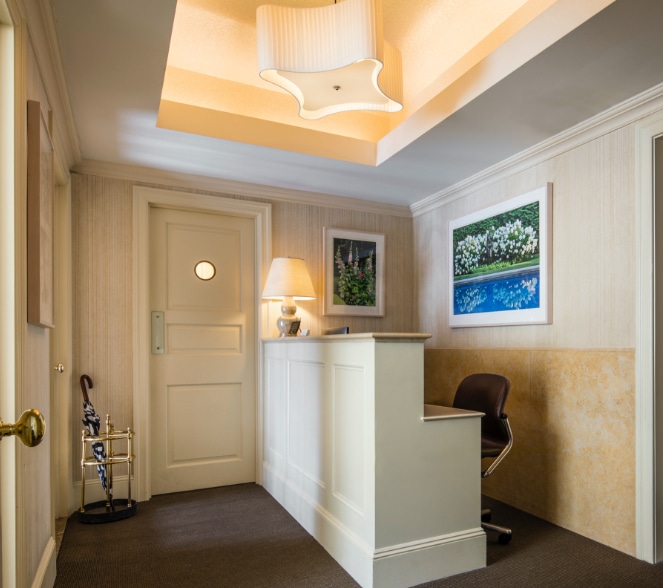'What Happens To Your Body.' February 2000.
After about ten minutes in plastic surgeon David Hidalgo's Manhattan waiting room, Kate—a 32 year-old, New York City financial consultant with a 36D chest— was ushered into an exam room. A nurse instructed her to take everything off above the waist and to put on a salmon-colored smock. Although this was Kate's second consultation with a breast reduction surgeon, she still wasn't comfortable. "I'm a modest person," she explains. "I'm not one of those types who prances around the locker room naked in front of other women." By this point, though, Kate had made up her mind to get what has become an increasingly popular operation: breast reduction surgery—something that many women (and certainly most men) can't understand.
After studying her body, Hidalgo asked Kate about her ideal breast size. If she wanted a marked decrease, by at least two cup sizes, Hidalgo explained, she may need a traditional surgical technique: an anchor incision that circles the nipple, drops down the center of the breast, and joins a horizontal incision in the crease of the breast. Most women don't like the scar because it tends to heal thickly and unattractively. If, however, Kate wanted a reduction of no more than one cup size, she could have a newer procedure called the Lejour technique. This method, Hidalgo told her, best removes a limited amount of breast tissue and leaves no horizontal scar under the breast, just a lollipop-shaped incision around the nipple and straight down to the breast crease. The idea appealed to Kate, who was realistic in her expectations, "I didn't want to become Cindy Crawford," she say. "I told Dr. Hidalgo that a C cup would be fine with me."
Hidalgo's first incisions followed the marks around the areola, the dark skin surrounding the nipple. a circular slab of nipple and areolar tissue was lifted but not completely detached, to maintain the blood supply. Than a wedge-shaped mass was removed from under the nipple. Next, following his purple surgical markings, Hidalgo cut a wide V-shaped incision from the base of the breast up to the level of the nipple and removed more tissue. He alternated between breasts to create equal volume and shape, removing almost a pound altogether.
Hidalgo then closed the sides of the incision with temporary surgical staples and propped up Kate to preview the result. Satisfied with her new shape, he used 25 stitches inside and out to close each breast. The final step: The surgical nurses placed layer of gauze over the incisions and put Kate in a large, soft cotton-and elastic surgical bra with Velcro closures on the front.
The Recovery
About four hours after the surgery began, Kate wheeled into the recovery room. All she remembers is being groggy. "I was so tired, and my throat felt dry from the anesthetic tubes, but strangely I wasn't in any pain," she says. Within three hours, she was well enough to go home with her husband and a nurse. The long-acting pain killers injected during the surgery kept her comfortable on the drive home, but a slight soreness set in several hours later. It was nothing, she says, that a dose of Tylenol with codeine—prescribed by her doctor—couldn't fix.
That evening, she had the bed to herself. "My husband was afraid he'd roll over on me, so he stayed on the couch," recalls Kate. "I slept with two pillows propped up under my head, and since I couldn't sleep on my side like I was used to, I had support pillows all around me to keep me from turning over." The next day, when her nurse opened the bra to change the dressing, Kate's first thought was, "Oh, my God."
"My breasts looked so new," she says. "Even though they were swollen and hard, they were smaller and had such a nice shape, I was gawking." The following day when Kate woke up, she looked at her breasts again in the mirror just to make sure she wasn't dreaming.
Although she felt well, Kate was fairly helpless. Simple daily acts like lifting her arms to get into a shirt, reaching for a phone on her night table, opening the refrigerator, emptying an ice tray, and reaching into an cabinet for a glass were all forbidden. "the breasts sit on top of strong pectoral muscles that run from the center of the breastbone to the arm," explains Hidalgo. "Every upper-body movement involves these muscles, which is why it is so important to minimize movement and protect the area while it's healing." Even carrying a tote bag was forbidden for the first few weeks.
Kate's first post-surgery shower, two days later, wasn't fun. "I couldn't face the water stream because I didn't want it to hit my sore breasts," she says. The only problems she experience were minor: oozing from the incisions and a small rash—both of which cleared up almost immediately after being treated with prescription creams. Then, five days after the surgery, Kate had the sutures around her nipples removed; the rest were left in to be absorbed by her body over time.
"Everyone had to be careful hugging me," says Kate, of her return to work the following week. "They patted me gently on the back, afraid that I might break." But "the real celebration was two weeks later," she says, "when I could finally sleep on my side." Sex was also permitted. After six weeks, vigorous upper-body exercise, tennis, and jogging were okayed, and, after two months, underwire bras were allowed. ("Before then, the wire might rub the lower part of the scar, irritating it," Hidalgo told Kate.)
Now, nearly four months after the surgery, Kate feels no pain. She's dropped from her original size to a small 34C and has happily discarded all of her 36D bras. "My scars look as if a thin red pen has circled the nipples, but everyday they get lighter," she explains, "I barely notice them anymore." Even nipple sensation has returned. About two months after surgery, Kate found herself in a frigid, air-conditioned restaurant and felt a familiar sensitivity in her breasts. "I knew right away," she says." The feeling had returned, and my breasts were back to normal."




